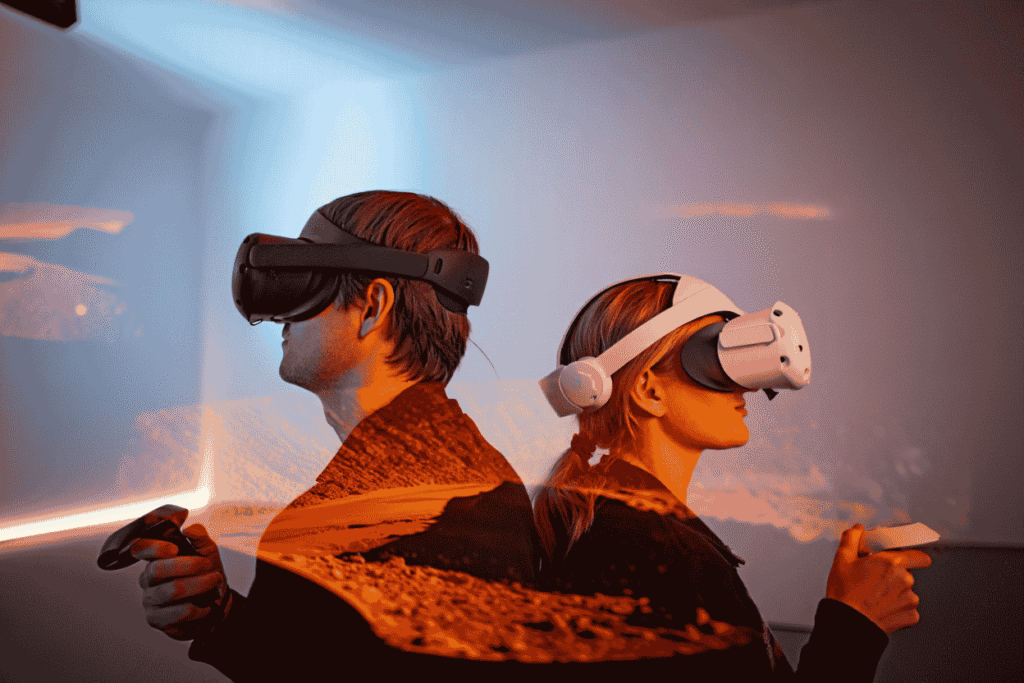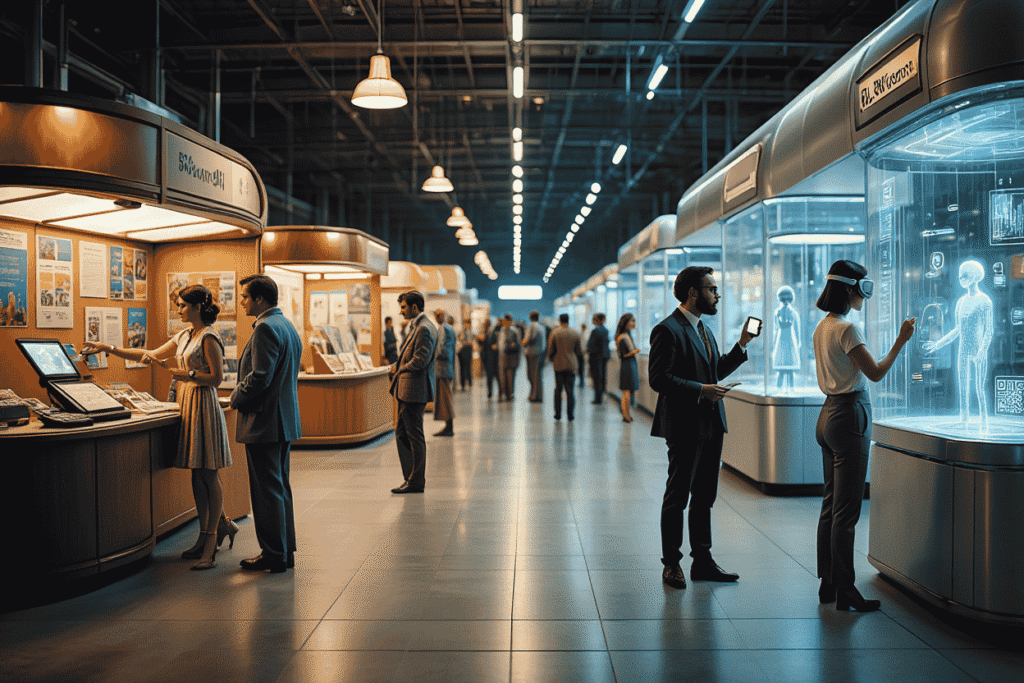From handcrafted wooden booths to holographic displays, the world of exhibitions has undergone a transformation so profound that it mirrors the digital revolution itself. What began as a space for brands to display their products has evolved into a realm where data, design, and digital experiences converge to create immersive, intelligent, and inclusive encounters.
The Evolution: From Showcase to Experience
For much of the 20th century, exhibitions were built around physical presence-people, products, and printed materials. The primary goal was to show and tell. Exhibitors handed out flyers; visitors collected business cards; success was measured in footfall and handshakes.
But the arrival of digitalization-accelerated by the COVID-19 pandemic-redefined every layer of the exhibition experience. As Anita Proszowska (2025) explains in The Place of Technology in the Evolution of Modern Trade Fairs, trade shows, once driven by static displays, are now technology-driven business tools. Exhibitors no longer compete on booth design alone, but on how effectively they integrate technology from AI matchmaking platforms to VR-enhanced storytelling.
The pandemic forced the industry to leap ahead technologically. In 2020, when physical events shut down, exhibitions went virtual. Screens replaced stages, and networking shifted to digital meeting rooms. Yet this wasn’t the end of physical fairs, it was a reboot. The modern exhibition now blends the best of both worlds: hybrid spaces where digital innovation amplifies human connection.
The Digital Turn: How Technology Reshaped the Exhibition Ecosystem

1. Artificial Intelligence-The Invisible Organizer
AI is the silent architect behind today’s exhibitions. It analyses visitor data, predicts interests, and matches attendees with the right exhibitors, much like a digital concierge. According to Proszowska (2025), over 80% of event organizers now use AI tools to personalize experiences, automate logistics, and evaluate performance.
From smart registration systems that scan social media profiles to AI chatbots that assist attendees in real-time, artificial intelligence has made exhibitions smarter, faster, and more efficient.
Yet, AI’s impact goes beyond convenience. It supports sustainability goals by reducing printed materials, optimizing energy use, and eliminating redundant logistics. Exhibitions have become not just smarter but greener.
“AI has turned exhibitions into intelligent ecosystems that learn from every visitor click and movement.”
2. Virtual & Augmented Reality-From Seeing to Feeling
While AI works behind the scenes, VR and AR technologies transform what visitors see and feel.
Kwangsik Choi and Yoonjae Nam’s (2024) study Do Presence and Authenticity in VR Experience Enhance Visitor Satisfaction? found that virtual experiences elevate satisfaction by creating a sense of presence, the feeling of “being there.”
In museums and exhibitions worldwide, VR is used to recreate historical sites, simulate manufacturing processes, or let visitors “walk through” a digital prototype. The researchers highlight that authenticity, not just realism, drives engagement. Visitors value the emotional truth of the experience, even when they know it’s virtual.
This principle extends directly to exhibitions. Imagine entering an automotive stand in Dubai where visitors put on a VR headset to test-drive a car on Mars, or exploring a real estate project through a 3D AR overlay that projects the building onto an empty plot.
These experiences go beyond visual appeal; they build memory and emotion, two cornerstones of brand loyalty.
“VR doesn’t just show, it transports. Visitors no longer walk through stands; they step into the stories brands tell.”
3. The Power of Digitalization-Beyond the Booth
The simple QR code, once a niche marketing tool, has become symbolic of the digital exhibition age. As Proszowska’s research notes, exhibitors now use QR and NFC technologies to replace printed catalogues, manage attendance, and track engagement. Wireless headphones allow multilingual presentations in open halls without distractions.
Event apps and CRM-linked software create a continuous visitor journey: before, during, and after the event. Attendees receive digital invitations, personalized schedules, and AI-generated follow-ups extending engagement well beyond the event hall.
Technology has turned exhibitions from events into platforms-continuous, data-driven ecosystems where relationships grow long after the lights dim.
The Human Element: Technology That Feels Personal

Despite all this innovation, the essence of exhibitions remains human- the handshake, the shared curiosity, the spark of conversation. What technology has done is to enhance the emotional texture of these moments.
Choi’s (2024) research shows that people respond most positively to existential authenticity experiences that make them feel genuinely connected, not just impressed. VR, AR, and AI succeed when they amplify this connection, when visitors feel seen, heard, and engaged as individuals.
The same principle applies to trade fairs. Whether through live chat, interactive games, or data-driven personalization, technology has shifted exhibitions from transactional spaces to relationship-driven experiences.
“Technology didn’t replace exhibitions, it expanded them beyond the hall walls.”
The Broader Impact: Accessibility, Sustainability, and Inclusion
The digital revolution in exhibitions didn’t just change how we present; it changed who can participate.
Hybrid formats allow global attendance without the cost or carbon footprint of travel. Remote participation tools mean that a designer in Nairobi or a student in Manila can experience a Dubai exhibition live through VR.
Sustainability, too, is no longer a side note; it’s a strategic pillar. Digital tickets, virtual catalogues, and modular, reusable stands reflect the industry’s shift toward eco-consciousness. Technology has made exhibitions not only more immersive but also more responsible.
The Future: AI, Metaverse, and the Next Experience Frontier
The next chapter is already being written. AI will soon personalize entire event journeys in real time, from suggesting sessions to adapting booth content based on visitor reactions. The metaverse is emerging as the next exhibition arena: a persistent digital world where companies maintain virtual pavilions open 24/7.
Meanwhile, holographic displays, spatial computing, and digital twins are blurring the lines between physical and virtual space. Future exhibitions may exist simultaneously in Dubai, Tokyo, and online, connecting audiences without borders.
But amid all this futuristic promise, one truth stands firm: technology’s purpose is to bring people closer, not apart. The most successful exhibitions will be those that blend silicon with soul data with design, and innovation with empathy.
Conclusion: From Events to Experiences
Exhibitions have evolved from temporary showgrounds to enduring experiences powered by technology.
Artificial intelligence organizes them, virtual reality enriches them, and data sustains them, but the human desire to connect remains their heartbeat.
The transformation is not just technical; it’s philosophical. Exhibitions are no longer about showing products; they’re about sharing experiences.
And in that evolution lies the future of the industry: immersive, intelligent, inclusive.


Leave a Reply